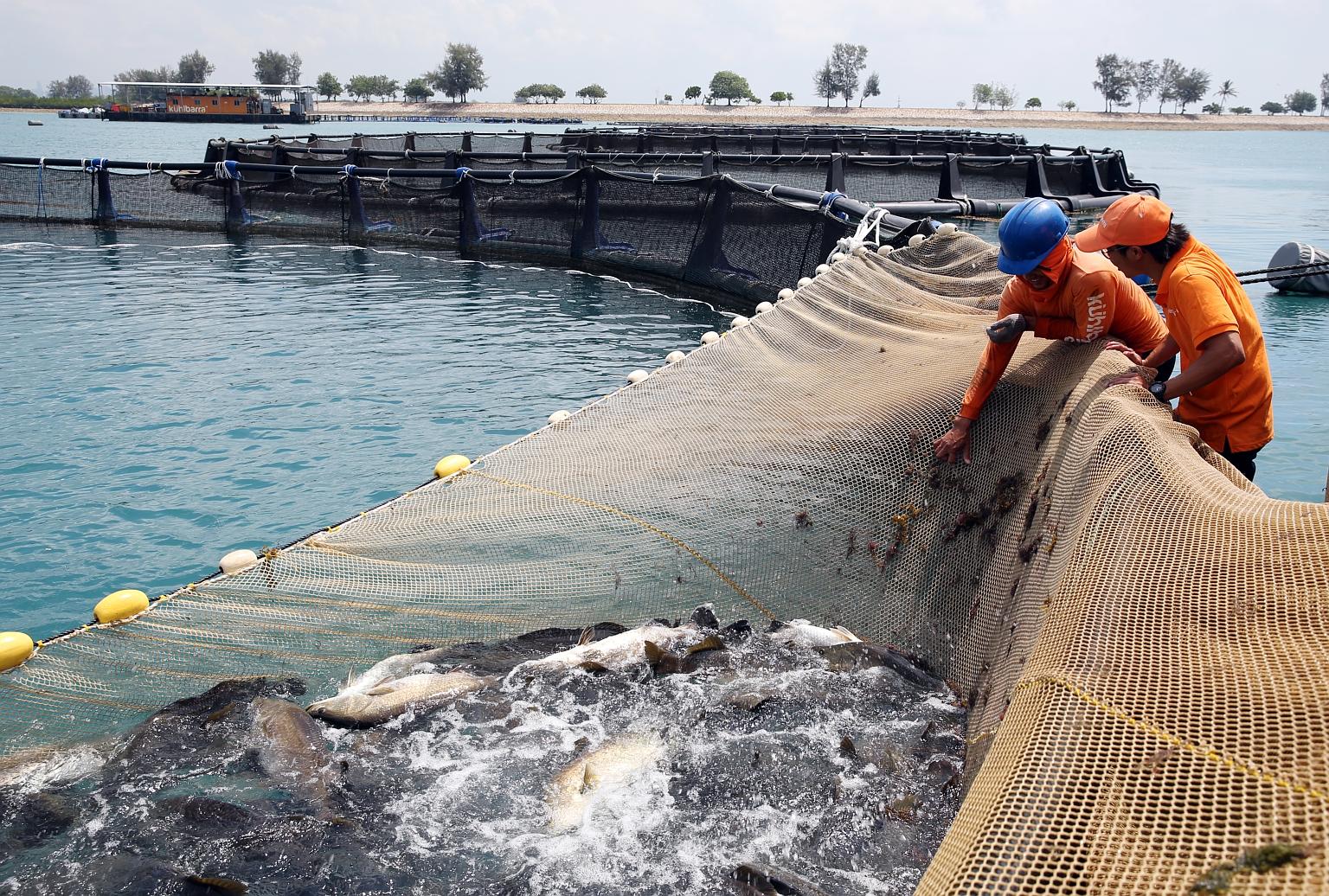With wild-caught fish stocks falling, S'pore looks to aquaculture
Sign up now: Get ST's newsletters delivered to your inbox

The 123 fish farms in Singapore produced about 4,600 tonnes of fish last year, accounting for about 9 per cent of local fish consumption. With ocean warming affecting fish stocks globally, aquaculture has become a necessity.
ST FILE PHOTO
Follow topic:
To feed Singapore at a time when global warming and overfishing are decimating global fish stocks, the authorities are looking to seafood farmed Singapore-style for a reliable protein source: high-tech, high-yield and climate-proof.
The Singapore Food Agency (SFA) told The Straits Times that a decline in wild-caught fish has made aquaculture increasingly important.
There are currently 123 fish farms in Singapore. They produced about 4,600 tonnes of fish last year, accounting for about 9 per cent of local fish consumption. Local production will help mitigate the nation's reliance on imports and serve as a buffer during supply disruptions, said the agency.
"We envisage farming to become more like manufacturing - where production takes place within a controlled environment with a defined input," said an SFA spokesman.
"The result is an assured and consistent output, and a predictable way to address the effects of climate change and extreme weather."
Globally, the aquaculture sector is growing. Professor Dean Jerry, deputy director for the Centre for Sustainable Tropical Fisheries and Aquaculture at James Cook University, told ST that aquaculture production has surged over the last 30 years - from comprising about 10 per cent of seafood protein globally to more than half now.
He said land-scarce Singapore is also looking to aquaculture because it is the most efficient animal protein production sector globally.
"To produce the equivalent kilogram of protein requires substantially less land area, water usage and feed input, and often is less polluting in terms of the production of planet-warming gases like carbon dioxide and methane, compared with beef production, for example."
An aquaculture farm can produce up to 50 to 80 tonnes of fish per hectare, while a semi-intensive beef farm will produce about two tonnes of products per hectare, Prof Jerry said.
Aquaculture has become a necessity because the pressures on the oceans are mounting. The latest scientific report released by the United Nations yesterday highlighted exactly how dire the situation is likely to become, if global warming continues unabated.
The Intergovernmental Panel on Climate Change's (IPCC) Special Report on the oceans and cryosphere - the frozen part of the planet - also highlighted how seafood might literally be swimming away.
Ocean warming in the 20th century and beyond has also contributed to a decrease in maximum catch potential, the report noted.
Dr Jess Melbourne-Thomas, one of the authors of the IPCC report, said ocean and ice environments around the world are changing at an unprecedented rate, and that many of these changes will accelerate.
Added Dr Melbourne-Thomas, who is from the Commonwealth Scientific and Industrial Research Organisation: "Changes in these environments - which include sea-level rise, ocean warming, melting ice and snow, and loss of oxygen in the surface ocean - have profound consequences for ecosystems and for human communities globally."
Fish farming may ease the shortage, but it is no panacea.
Prof Jerry pointed out that because aquaculture is essentially an outdoor food production sector, increased extreme environmental events such as cyclones, droughts and heatwaves could dramatically interfere with production systems.
Rising temperatures can also speed up pathogen life cycles and increase the likelihood of disease outbreaks, Prof Jerry noted. Already, about 40 per cent of current aquaculture production is lost to disease globally.
Warmer waters could also exacerbate harmful algae growth and that can kill fish or render them too toxic to eat.
Fish farmers in Singapore have not been spared. They are now leveraging technology to overcome some of these challenges.
For example, Singapore Aquaculture Technologies - a fish farm in the Johor Strait - has been using closed containment aquaculture systems which separate the water in the fish pens from sea water.
Genetic improvement could also be another way to increase the productivity of a farmed species, said Prof Jerry, who is also director of the Australian Research Council's Research Hub for Advanced Prawn Breeding.
"We are looking at prawns as they are one of the major global aquaculture production industries which are highly efficient and... (have) high export value. So what we are doing is selectively breeding for faster-growing, disease-tolerant, good-tasting black tiger prawns."

